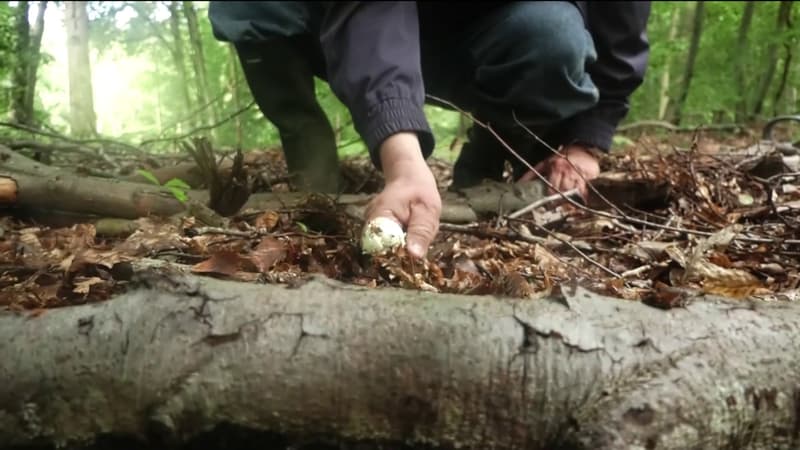Autumn is here, the leaves are adorned with orange colors and mushrooms grow in the forests. The temptation to pick them to prepare a stir-fry at night is great, but be careful. Gluttony must rhyme with caution.
Poisoning centers recorded around 500 poisonings related to the collection and consumption of mushrooms between July 1 and September 25, 2025, indicates the ANSES (National Agency for Food Safety, Environmental and Occupational Health).
For the entire year 2024, 1,363 cases were recorded in mainland France, of which around 3.1% were cases of “very severe severity, including three deaths and three cases of chronic kidney failure”, according to ANSES.
Several people are still hospitalized in mid-October in France due to these poisonings. Some are located in particular in the intensive care and resuscitation department of the Rennes University Hospital, as reported by Ouest-France.
The right tools to avoid risks
“The most serious cases involve amanita phalloides [une espèce de champignon, NDLR]which can cause brutal destruction of the liver,” explains Dr. Gaël Le Roux, toxicologist pharmacist at the Grand-Ouest Toxicology Center, based at Angers University Hospital, to BFMTV.com. In fact, some patients are in intensive care and must undergo a liver transplant.
Therefore, so that the tasting continues to be a moment of pleasure, it is advisable to follow some recommendations.
Before going out to look for mushrooms, you should already equip yourself with the right tools. “You have to carry a basket and not a plastic bag, a knife and not scissors and, ideally, a camera or a smartphone,” emphasizes Gaël Le Roux.
So forget about the plastic bag, which “can spoil mushrooms, even edible ones.” The knife is necessary to dig out the mushroom. Sometimes what allows us to identify a species is found at the bottom of the mushroom or even in the soil.
Finally, taking photographs is useful in case of poisoning, because keepers will be better able to recognize a species when they pick it up, rather than after it is cooked.
Don’t choose without being sure
Above all, you should not pick mushrooms that you do not know and do not trust phone applications. Prefer a mycology manual and ideally do the collection with someone who knows it perfectly.
As the French administration’s website indicates, “confusion between multiple species can be the cause of serious poisoning, in particular between chanterelles or chanterelles and the clitocybe olivo or even between the amanita phalloides and the coumella.”
The best-known mushrooms in France are undoubtedly porcini mushrooms. They are recognizable by their reddish-brown cap and firm white flesh. The foot is generally clear and smooth. Be careful, “the porcini mushroom never turns blue when cut,” specifies the Champeurs de Champignons website.
Go to the pharmacy if you have the slightest doubt.
If the harvest is good, it is advisable “not to mix them, because this avoids having to sort them once at home and forgetting some that could be toxic.” In case of doubt, even the slightest, it is advisable to go to a pharmacy or a mycology association.
Once you get home, you should wash your hands. Dr. Gaël Le Roux recommends cooking them for at least 20 minutes. “It is strongly recommended not to eat them raw.” Children and vulnerable people should avoid consuming these mushrooms as much as possible, even cooked.
Also, if you have doubts about the collected mushrooms, you should not give them to pets either. If it is bad for humans, it is also bad for dogs or cats.
Symptoms to take seriously
If, despite all these precautions, symptoms occur (nausea, vomiting, sweating, dizziness, hallucinations) then a Poison Control Center should be called.
It can be simple indigestion but also serious poisoning. One of the indicators could be the time before symptoms appear. “If they arrive within six hours of ingestion and continue for more than a day, then we should be concerned,” explains Gaël Le Roux.
Logically, the sooner support occurs, the better. “We have an antidote that is more effective when taken early,” adds the health professional.
Mushroom picking is a lovely moment to share with family or friends, but vigilance is always the most important thing. “We are worried that people pick mushrooms without knowing how to do it,” laments the toxicologist pharmacist.
Poison Control Center Emergency Numbers:
Angers: 02 41 48 21 21
Bordeaux: 05 56 96 40 80
Lilac: 08 00 59 59 59
León: 04 72 11 69 11
Marseille: 04 91 75 25 25
Nancy: 03 83 22 50 50
Paris: 01 40 05 48 48
Tolosa: 05 61 77 74 47
Source: BFM TV


